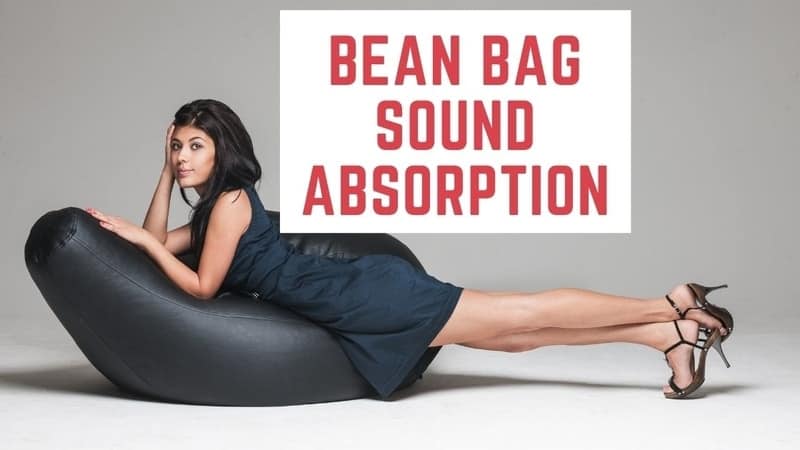Absorbing sound is not the primary task we expect from a bean bag. But if you are living in an apartment or you are using bean bags for your recording studio, you might need to clarify whether do bean bags absorb sound or not.
Bean bags do absorb sound. Bean bag filler is the main reason for this absorption. The level of sound absorption highly depends on the filler used in the bean bag. EPS beads, Sand, and Worn out Fabrics are among the highest sound absorbing fillers for Bean bags.
Now, Let’s go deep into this.
Before we dig into the sound absorption of bean bags, we need to understand the mechanism of sound absorption in different materials. Then we can identify the perfect fillers and bean bags for our requirement on sound absorption or preventing sound absorption using bean bags.

Table of Contents
- Mechanism of Sound Absorption
- What Makes Bean Bags Absorb Sound?
- Different Fillers for Different Absorption
- Conclusion
Mechanism of Sound Absorption
Each and everything in the universe can absorb sound, whether they are soft, hard, liquid, or even gas. However, not every material in the universe absorbs sound in the same way or the same amount.
Some materials absorb the energy of sound, which collides on their surface much more than others, and such materials are the ones we usually call “Acoustical Materials“.
These “acoustical materials,” whether natural or artificial, Can be categorized into two main groups.
- Soundproofing (These acoustical materials can prevent the transmission of sound energy)
- Sound-absorbing (These acoustical materials can absorb the reverberant energy that sound creates within a space)
While in theory, we consider soundproofing and sound absorbing to be two things, but when in practice, sound-absorbing is a part of soundproofing.
Adding mass, damping, decoupling, and absorbing are the four main concepts of soundproofing. It is not all about sound absorption.
Things we use when we are soundproofing an environment are always dense and heavy. Heaviness and higher density allow these materials to decouple structures. Because of these structures’ higher density, the waves of sound cannot penetrate them and travel through to the other side.
Instead of that, the sound is reflected into the outer space they came from.
Soundproofing is about stopping the sound waves coming from outside, while sound-absorbing is about softening and weakening the sound waves that are already there.
This phenomenon makes sound absorption much more helpful than soundproofing when we need to control noises and voices within an environment which is mostly enclosed.
What happens with absorbing materials is what precisely the name suggests. These materials absorb most of the energy they are exposed to by the sound waves and reflect very little of it to the environment.
I am sure you all have learned that energy can never be created or destroyed by any means in middle school. All one could do with energy is transforming them into a different kind of energy.
“Energy cannot be created or destroyed, it can only be changed from one form to another.”
Einstein
Sound-absorbing materials are doing the same thing with the energy of sound waves they are colliding. According to the cellular structure of the sound-absorbing object’s material, the energy of the sound waves is transformed into heat, mechanical, or deformation energy.
However, they mainly change into heat if the acoustical material is a pillow, cushion, or bean bag, according to the experts.
You do not have to be alarmed with the knowledge that your bean bag is turning sound into heat, as the exact amount of heat generated through sound waves is much less than 1/1,000,000 of a watt.
In other words, you won’t even feel the heat generated by the absorbed sound waves.

What Makes Bean Bags Absorb Sound?
There is more than one type of sound-absorbing material globally, and their ability to absorb sound is different from one another. This ability depends on the frequency of distribution, composition, and thickness of the material and the method of mounting it.
However, all of these absorbing materials are divided into three primary types known as porous, membrane, and resonance.
Things like cushions, pillows, and bean bags are considered to be porous sound absorbers. These sound absorbers are not as thick as soundproofing materials, and so the sound waves can easily penetrate them and travel into the very cellular structure they are made from.
This mechanism helps the porous material they are made to collide with the sound waves and easily absorb large amounts of their energy and transform them into insignificant amounts of heat energy.
According to the experts, the materials with the highest sound absorbing qualities are usually porous.
A larger material provides more sound absorption, while a smaller material provides less sound absorption. If you have a bigger bean bag, the chances of softness in the noises and noise around you are much high. You can arrange a group of bean bag chairs on the floor of your living room or even bedroom and have a funky-looking seating area which also acts as a highly effective sound absorber.
You need to keep in mind that porous sound absorbers such as bean bags are most effective for mid-range frequencies or treble tones. In other words, they have a more negligible effect on the lower frequencies and even less effect on bass.
Different Fillers for Different Absorption
Not all materials act the same way when it comes to absorbing sound, as said before. So, you will have to be careful when selecting the best filler for your bean bag if your goal is to make it sound-absorbing.
EPS beads: These are the most common fillings to be found in bean bags, and they are comparatively more effective when it comes to absorbing sound due to their porousness.
Beans: You can use beans to fill your bean bag, as the name suggests, but it won’t be the best choice when it comes to sound-absorbing, mainly because of their thickness.
Sand: This cheap and eco-friendly bean bag filling alternative is more soundproofing than sound-absorbing. The reason for this is as it is both heavy and made up of tiny grains that don’t leave any gaps in between.
Worn-out fabrics: These are among the best cheap materials you can find to fill your bag of beans to make it sound-absorbing. They have all the qualities of a Porous sound absorber, and they will be more effective as their thickness increase.
Plastic bags: This is not the best eco-friendly choice on the table yet still among the best choices when it comes to soundproofing your home. They only allow 68 decibels through them.
Quilt and pillow stuffing: They will provide your bean bag comfort of well as the sound-absorbing ability. Quilt and pillow stuffing is among the best Porous sound absorbers.
Paper waste: This is another cheap material with ideal qualities to make your bean bag into an effective sound absorber, but you should keep in mind that not all papers are for the task.
Conclusion
First, you need to understand your requirement when selecting a bean bag. Bean bag’s primary purpose is to provide you with the best possible seating experience, while the sound-absorbing quality is an unanticipated advantage. But if you need more focus on sound absorption, you need to select a filler with more sound absorption characteristics.
